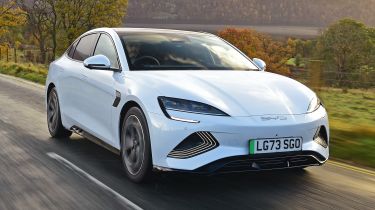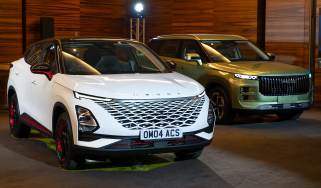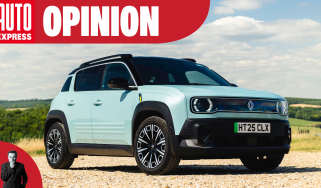BYD Seal review
The handsome BYD Seal puts forth a strong case for itself as a well-made, fine driving, and efficient electric vehicle

Is the BYD Seal a good car?
The BYD Seal is the Chinese brand’s most impressive UK offering to date, with excellent range, efficiency, and performance. It even has a well-finished interior with lots of standard equipment to give it the feel of a premium electric vehicle, so much so that it might make you think twice about a Tesla Model 3.
However, its high equipment levels and swift performance mean the Seal has a higher price than we’ve been used to from BYD. Whereas the brand’s other models have undercut rivals, the Seal is priced directly to compete with premium EV offerings – or, in the case of the Tesla Model 3, above them. We still think it's worth considering the Seal, but it opens the car up to closer scrutiny against rivals that are more fun to drive, charge faster, and offer greater practicality
| Key specs | |
| Fuel type | Electric |
| Body style | Four-door saloon |
| Powertrain | 82.5kWh battery, 1x e-motor (Design) rear-wheel drive 82.5kWh battery, 2x e-motor (Excellence AWD) four-wheel drive |
| Safety | 5-Star EuroNCAP (2023) |
| Warranty | 6yrs/93,750 miles |
About the BYD Seal
BYD has some lofty ambitions with the Seal, as shown by its price, which starts at just under £46,000.
That’s significantly more than the car the Seal has to beat in this sector, the Tesla Model 3. If you want a four-wheel drive Seal, then you’ll need to go for the top-of-the-range Excellence AWD at nearly £49,000.
While the pricing is punchy, it also seems a little strange that a car maker would launch a saloon car when more and more buyers are defecting to SUVs, but the BYD Seal is not your normal compact executive saloon. It differs from rivals like the Audi A4, BMW 3 Series, and Mercedes C-Class in being an all-electric offering like the aforementioned Model 3. Going electric brings lower company car tax implications than hybrid or even plug-in hybrid alternatives, which is crucial in this market.
All versions of the Seal come with the same 82.5kWh (usable) battery size, with an overall driving range from the entry-level rear-wheel drive of 354 miles. That’s a mighty impressive number, although it has been announced that the Seal is going to be updated with an upgraded battery that’s smaller in capacity at 80.6kWh. There is no word on whether the WLTP range will change, but we expect there to be some efficiency upgrades made to the electric motor to at least maintain or improve that figure.
The model range is very simple, consisting of just two trim levels: Design and Excellence. Our preferred Seal is actually the entry level rear-wheel drive Design trim, which actually has a specification that reads more like that of a luxury car than a fleet favourite.
Key features of Design trim:
- 19-inch alloy wheels
- LED headlights
- Electrically adjustable heated and ventilated front seats
- Surround-view camera system
- 12-speaker Dynaudio sound system
- Electric tailgate
Key features of Excellence trim:
- A head-up display
- Adaptive suspension
- Four-wheel drive
The latter is the fastest Seal, with a 0-62mph time of just 3.8 seconds thanks to a mighty 530bhp on tap from its dual motor set-up. That’s not to say that the entry-level rear-wheel drive Design model is a slouch, because it still has a not inconsiderable 312bhp to play with.
If you're interested in purchasing a BYD Seal, we can assist you. Configure your ideal BYD Seal now to get top offers from local dealers, check out the latest BYD Seal leasing deals or search for used BYD Seal models with our Find A Car service. You can even sell your existing car for a great price with Auto Express Sell My Car.
BYD Seal prices and latest deals
Electric motors, performance & drive
| Pros |
|
| Cons |
|
The BYD Seal is quick enough in our preferred rear-wheel drive Design trim with a 0-62mph time of just 5.9 seconds. It’s refined enough, but it needs a little more fine tuning to compete with the likes of the BMW i4. The accelerator could be a little more responsive, and we’d like a smoother transition between the regenerative and mechanical braking systems.
Underpinning the BYD Seal is the same e-Platform 3.0 used on the existing BYD Atto 3 SUV and BYD Dolphin supermini, upscaled for the saloon’s extra length. It’s the first of BYD’s Brit-bound models to switch from front to rear-wheel drive, though you can get a top-spec Excellence version with an additional motor on the front axle to make the Seal four-wheel drive.
Performance, 0-60mph acceleration and top speed
The entry-level rear-wheel drive SEAL gets from 0-62mph in just 5.9 seconds, which is faster than the equivalent BMW i4 eDrive30 and Tesla Model 3 RWD, providing more than enough performance to make it our preferred version of the Seal.
The top-of-the-range Excellence AWD model officially takes 3.8 seconds to get from 0-62mph, but we recorded a 3.7-second sprint using its dedicated launch control mode on a closed track. It’s no faster flat-out than the rear-wheel drive model, with both versions hitting 111mph.
Town driving, visibility and parking
Thanks to its standard adaptive suspension, the four-wheel drive car feels like the most focused Seal to drive. At low speeds, there’s a slight chatter from the ride around town, but this settles at higher speeds, where the fancier suspension does a much better job of disguising the Seal's mass than the passive set-up of the rear-wheel drive Seal.
Around town, we prefer the regenerative braking set-up you’ll find in the Hyundai Ioniq 6, which uses paddles behind the steering wheel so you can select between varying strengths of regeneration, from a coasting mode for motorway driving up to a one-pedal drive mode for driving in stop/start city traffic. The system in the Seal is too subtle, making it difficult to bring the car to a halt just by lifting off the accelerator pedal.
B-road driving and handling
The latter version is softer and less controlled than the BMW i4 over lumpy B roads, and isn’t as satisfying to drive as a result. Both versions of the Seal have fairly pronounced body lean in corners when pushing on, and an intrusive stability control system curtails any attempt to drive enthusiastically. Still, with weighty steering and a low driving position, the Seal is unquestionably the brand’s most driver-oriented car to date.
The BYD Seal is a quick car, though The entry-level 308bhp rear-wheel-drive model provides all the performance you’d need, while the flagship four-wheel drive Excellence model ups the ante to 523bhp. However, both versions suffer from a less responsive accelerator than rivals, giving the feeling of old-school turbo lag when trying to make a spirited getaway from the lights, and blunting the feeling of punchy acceleration we’ve come to expect from high-performance EVs.
The main difference between the entry Seal Design and the flagship Excellence AWD is the additional electric motor powering the front wheels to give the Seal four-wheel drive. The system utilises BYD’s Intelligent Torque Adaption Control (iTAC) system, which is, in effect, a torque-vectoring set-up that aims to reduce slip and increase traction in slippery conditions. We found that the four-wheel drive provided plenty of traction, even in some of the worst weather the north of England could throw at us. In the end, we’d still recommend the standard rear-wheel drive model, because it’s perfectly capable of handling most needs and situations.
Motorway driving and long-distance comfort
The BYD isn’t as quiet as the i4 at higher speeds, even though the side windows of the Seal are laminated to dampen wind noise at higher speeds.
We also think the Seal’s brakes could use a little more initial bite, especially given that the Seal is a heavy car with a lot of mass to slow down. The pedal travel is long, and there’s a distinct step between the regenerative braking system and the mechanical braking system.
| Model | Power | 0-62mph | Top speed |
| Design | 308bhp | 5.9s | 111 mph |
| Excellence AWD | 523bhp | 3.8s | 111 mph |
“The Seal isn’t helped by a slow responding throttle, which gives it a character that’s reminiscent of an old-school turbocharged car, with a modest initial push followed by a great surge moments later. With so much performance potential, we would have liked to apply the power a little more progressively.” – Alex Ingram, Chief reviewer
Range, charging & running costs
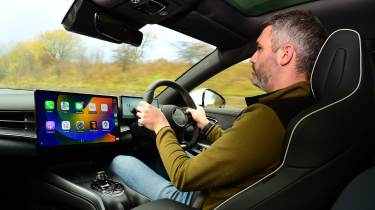
| Pros |
|
| Cons |
|
The rear-wheel drive model is our preferred version because its official range of 354 miles compares well with similarly priced rivals. The Excellence AWD has proven to be less efficient than its rivals, which is a little concerning for long trips when the charging speed lags behind the class best. Predicted resale values are likely to be on par with its competition, but insurance is likely to be expensive, considering the Seal sits in some of the highest insurance groups.
Electric range, battery life and charge time
The base rear-drive BYD Seal has a maximum claimed range of 354 miles, while the four-wheel drive version has a nearly nine per cent drop to 323 miles. That’s due to the inefficiencies of having an additional electric motor driving the front wheels and a weight penalty of around 130kg compared with its sibling. Both versions use an 82.5kWh capacity battery.
We haven’t had a chance to range test a rear-wheel drive Seal yet, but the four-wheel drive version proved to be the least efficient EV during our company car group test, with only 3.0mi/kWh. That’s a shame, because it has a larger battery than the equivalent dual-motor Tesla Model 3, yet the latter managed 3.8mi/kWh, allowing it to go significantly further on a charge. We expect the lighter rear-wheel drive Seal to have a much better efficiency.
A peak charge rate of 150kW is slightly down on all the main competitors, especially against the Hyundai Ioniq 6, which can handle up to 233kW. This means the Seal has a relatively slow 10-80 per cent (from roughly 35 miles of remaining range up to 280 miles) charging time from a suitable rapid charger of nearly 40 minutes. In comparison, the Ioniq 6 takes under 20 minutes. The Ioniq 6 has a smaller battery pack (74kWh usable), which will take less time to charge than the Seal (82.5kWh usable), but it also has a much higher peak charging speed than the Seal.
Most owners will probably charge the Seal overnight at home via a 7kW wallbox. In the worst-case scenario of refilling a completely flat battery, which few owners will ever do, it will take a little over 13 hours.
The battery is guaranteed to retain 70 per cent capacity for eight years or 125,000 miles, which is longer than the warranties on BMW and Tesla battery packs.
| Model | Battery size | Range | Insurance group |
| Design | 82.5kWh (useable) | 354 miles | 48D |
| Excellence AWD | 82.5kWh (useable) | 323 miles | 50D |
Insurance groups
Unfortunately, insurance is likely to be costly. The entry-level Design model is in group 48, which is considerably higher than the Hyundai Ioniq 6 in group 36, and the BMW i4 and Volkswagen ID.7, which both start in group 38.
The top-of-the-range Excellence AWD is in the highest group 50 ranking, which is higher than the most potent M50 version of i4, and is also above that of the even faster Kia EV6 GT, which is in group 45.
Tax
The Seal will make sense to company car drivers because of the low Benefit-in-Kind (BiK) tax band electric cars sit in, at least until 2025. It’ll also be exempt from the London Congestion Charge until Dec 2025, too.
However, EVs no longer enjoy free road tax, and no version of the Seal costs less than £40,000 when new; as a result, your annual vehicle excise duty (VED) charge is likely to be high. That isn’t uncommon for cars in this class, but it is still annoying when the popular Tesla Model 3 avoids this charge, provided you go for the least expensive version of it and don’t specify an expensive paint option.
Depreciation
Residual values for the Seal are likely to be in between its main rivals. Our expert data suggests that after three years and 36,000 miles, the Seal will maintain around 55 per cent of its resale value, putting it above the majority of its closest rivals. The Seal is ahead of the Ioniq 6, which is expected to maintain around 43 per cent of its value, and the BMW i4, which is predicted to hold on to between 44 to 48 per cent of its value. It’s even better than the Tesla Model 3, which is anticipated to be worth between 42 to 53 per cent of its original value over the same period.
To get an accurate valuation for a specific model, check out our free car valuation tool...
Interior, design & technology
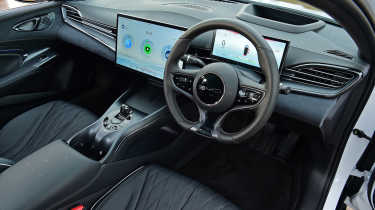
| Pros |
|
| Cons |
|
A handsome exterior design and a classy interior built with plush materials help to give the BYD Seal the premium feel its price demands. You get a lot of equipment for your money, and the standard ventilated front seats are a nice touch considering the full-length glass roof will make things quite hot in summer. We doubt you’ll need a rotating central touchscreen, but at least the screen responds swiftly to inputs. We approve of the separate digital driver instrument cluster, because it puts important information, such as speed, within the driver’s line of sight.
The exterior design of the BYD Seal is handsome, and looks sleek enough to cut through the air with maximum efficiency. You have a choice of four standard metallic colours, plus two premium paint colour offerings for just under £900 – which is quite reasonable given that such an option on the Tesla Model 3 is an excessive £2,000.
Given that the Seal has been priced to compete with premium electric offerings in the class rather than trade on value like its cheaper sibling, the BYD Dolphin, you’d expect the interior to be of a certain standard. Fortunately, the Seal doesn’t disappoint.
Interior and dashboard design
Inside, the wraparound dashboard design of the BYD Seal feels more sporty than some of rivals, and we appreciate the supplementary 10.25-inch screen in front of the driver, which puts important information such as speed and trip data right where you need it, rather than off to the side like in the Model 3, which relies on its central screen. The top-of-the-range Excellence trim goes further by providing a head-up display that projects your speed on to the windscreen within the driver’s line of sight.
The glass roof helps make the all-black interior less sombre, but if you want something a little more distinctive, you can also choose the Tahitian Blue alternative.
Materials and build quality
Quality is good throughout, and the soft-touch materials used across the top of the door cards are particularly classy. The seats feel suitably plush both front and rear, and following the recent revisions to the Tesla Model 3, those front seats are heated and ventilated as standard. The latter will be a welcome feature in the summer months given every Seal has a glass roof, which floods the cabin with light.
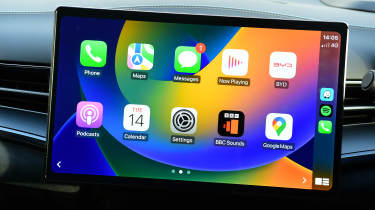
Sat-nav, stereo and infotainment
The infotainment system is a familiar one from other BYD models, and lifted wholesale from the Atto 3. The 15.6-inch rotating display runs on the same super-fast processor that makes it responsive to your inputs. We’re not entirely sure of the need for a rotating screen and its additional complication, though. After the initial interest of watching it rotate on its axis, some might prefer to keep it in its landscape orientation all the time so that the screen doesn’t obstruct your forward view.
There is a handy shortcut to some basic climate control adjustments, such as the temperature controls, that can be made via a menu in the digital driver’s instrument cluster and the buttons on the steering wheel. This saves you from delving into the menus within the central touchscreen, but it’s still a shame that you have to exit whatever screen you’re on within the main display to access all of the climate control functions. We can’t help but think that dedicated buttons would be even less distracting for drivers.
You can stream music through it using either Apple CarPlay or Android Auto, and you can keep your devices charged with the two wireless charging pads provided.
“If you enjoy listening to music, then the Seal is the car to have; the sound system is by Danish hi-fi brand Dynaudio, and its quality and power are absolutely superb.” – Alex Ingram, Chief reviewer
Boot space, comfort & practicality
Pros |
Cons |
|
|
The Seal's 400-litre boot is smaller than its rivals, while its saloon body style means it can be restrictive when loading taller items in the boot. The useful 53-litre front boot is convenient for storing dirty charging cables, just like the Tesla Model 3. There’s enough space up front for a pair of six-foot adults to sit comfortably, with enough space left over for a pair of similarly sized grown-ups in the back – although their heads will be close to the roof. You get a pair of ISOFIX child seat points in the back and another on the front passenger seat.
The BYD Seal is a four-door saloon that’s slightly bigger than the Tesla Model 3. Thanks to a super-thin ‘blade’ battery pack that doesn't take up too much space under the floor of the car, the BYD feels like a much bigger car inside compared to a traditionally powered petrol or diesel car.
All Seals come with front and rear parking sensors, along with a 360-degree camera system. The latter is often an expensive option on its rivals, and while it has a number of neat tricks, such as being able to generate an image of what’s below the car, the camera quality isn’t as sharp as it could.
Dimensions and size
The Seal measures 4,800mm in length, 1,460mm in height, and 1,875mm in width. That makes it bigger in all directions than the Model 3, but smaller than the Volkswagen ID.7 at 4,961mm in length. The extra size of the latter might become an issue when trying to park in a tight multi-storey car park, though.
| Dimensions | |
| Length | 4,800mm |
| Width | 1,875mm 2,150mm (inc. mirrors) |
| Height | 1,460mm |
| Number of seats | 5 |
| Boot space | 400 litres (main) 53 litres (front) |
Driving position, seats & space in the front
There’s enough room up front in the Seal for taller adults. All versions come with electrically adjustable front seats with electric lumbar support and driver’s side memory settings, so you can more easily recall your preferred seating position if more than one person is driving the car.
Seats & space in the back
An adult approaching six feet tall can fit in the back in the outer positions, although their head will be quite close to the roof lining. That being said, a Hyundai Ioniq 6 isn’t exactly stellar in this department, especially if you go for a version with a sliding glass sunroof. If you need to fit taller teenagers or adults in the back, then consider the Volkswagen ID.7. It provides a vast amount of head and limo-like leg room for rear seat occupants. It’ll be more comfortable on longer trips, too, because the high floor in the Seal and relatively flat seat base means it doesn’t have much under-thigh support.
The Seal comes with ISOFIX child seat mounting points on the front passenger seat, and the outer positions on the rear bench.

Boot space
The BYD Seal’s 400-litre capacity is some way off the 532 litres of capacity you get in a Volkswagen ID.7. You can’t drop the rear seats in the Seal, so it won’t be very useful for a trip to IKEA compared with the more versatile ID.7, or BMW i4. The latter gets a handy 40/20/40 split folding rear seat design.
The Seal's saloon bodystyle means it gets a narrow boot opening, making it much less easy to load taller items than the hatchback style i4 and ID.7. The BYD does have some helpful features, such as some underfloor storage for hiding smaller items away, and there’s a useful 53-litre boot at the front, like in the Model 3, for keeping the charge cables away from anything you don’t want getting dirty.
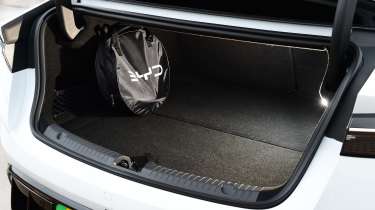
Reliability & safety
| Pros |
|
| Cons |
|
It’s too early to judge what the long-term ownership experience of a BYD car will be like, given the company has only just arrived on our shores, although the long six-year/93,750-mile manufacturer’s warranty should provide some reassurances. The battery pack is covered by an eight-year or 125,000-mile warranty, which is longer than most of its rivals.
With both the BYD Seal and the BYD brand being new to the UK market, we don’t have any data yet to include them in the latest 2024 Driver Power owner satisfaction survey, making it difficult to judge what long-term ownership is going to be like. On the positive side, the fit and finish of the BYD cars we’ve tested so far have been very good, and our service experience during our long-term ownership of a BYD Atto 3 hasn’t raised any cause for concern.
There may also be a period where dealership coverage isn’t quite as good as some of its more established competitors as the brand builds up its network. The same was true of MG and Tesla when those companies came to the UK, and that hasn’t prevented those brands from selling well in this country.
The Seal should be a safe car, because it was awarded a maximum five stars out of five by safety experts Euro NCAP in 2023. It matched the BMW i5 in adult occupancy rating, and did better in terms of child protection. It couldn’t match the Volkswagen ID.7, which did better across the board.
| Key standard safety features |
| Euro NCAP safety ratings |
|
Buying and owning
Our best buy: BYD Seal Design
We think the entry-level rear-wheel drive Design version is the best model to buy because it has the greatest range, and only misses out on a head-up display compared with the pricier Excellence trim. The rear-wheel drive car is also plenty quick enough in the real world that we don’t think it’s worthwhile spending the extra on the four-wheel drive Excellence trim.
Electric cars don’t have the same servicing requirements as regular petrol or diesel cars because they don’t have an engine that requires regular oil changes. Trips to the dealer for servicing are required every two years or 20,000 miles, which is similar to rivals, although Volkswagen allows you to cover an unlimited number of miles between visits.
BYD Seal alternatives
It isn’t just the traditional German saloon car choices or the Model 3 with which the Seal must do battle. There’s an array of other EV saloon offerings, such as the BMW i4, Hyundai Ioniq 6, and Volkswagen ID.7, that are all available with over 300 miles of range.
Plus, you could also consider EVs like the Hyundai Ioniq 5, Kia EV6, Nissan Ariya, Volkswagen ID.4 and Skoda Enyaq that, while perhaps not offering quite the same overall driving range due to having less aerodynamic SUV-style shapes, do all offer greater versatility than a saloon.
The BYD Seal feels like a much more mature product than either of the brand’s previous electric cars, but with that comes a tangible price premium that puts this sleek saloon on par with (or even slightly above) rivals, rather than allowing it to undercut them. Don’t let that dissuade you, because this is a well-equipped, high-quality, admirably efficient and good-to-drive EV that stacks up well both on paper and in the real world. It provides a comfortable and refined driving experience for anyone seeking an electric car to cover long distances.
Just be aware that while it is a credible alternative to a Tesla Model 3, the Model 3 charges much faster than the Seal despite its lower price in entry-level rear-wheel drive form, and would be more suitable for those who have to rely on public charging. Additionally, there’s the Volkswagen ID.7, which offers greater practicality than the Seal, or the BMW i4, which is more enjoyable to drive for those who value a B-road blast.
Deals on the BYD Seal and alternatives
Frequently Asked Questions
The BYD Seal provides excellent range and lots of equipment for the money, although some rivals offer faster charging speeds and a sharper drive for less money.
